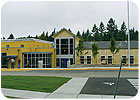
The original system design for an HVAC retrofit at this middle school included a specification for insulated galvanized steel HVAC ductwork. However, before the project could start, prices for the mechanical system jumped by about $500,000 over budget, which led the school district to explore other duct material options, such as fiberglass duct board.
In 2006, the Olympia School District (OSD), of Olympia, WA, had enough of being burdened with outdated mechanical and electrical systems at its Reeves Middle School. Though some new mechanical and electrical equipment was installed in 1998 during the construction of a cafeteria and auxiliary gym, most of the school still had old, inefficient equipment that had been in place since the school opened in 1970.
The school district’s Capital Planning & Construction Department (CPCD) planned a complete modernization of all electrical and mechanical wiring and equipment for the 65,642 sq-ft, one-story school.
“The school was in serious need of a mechanical and electrical modernization,” said CPCD project manager John McLaren. “The heat pumps on the roof were very old and the HVAC system was completely outdated. With newer equipment, we knew we could achieve greater energy efficiency.”
Design - Take 2
Plans called for a new, more efficient HVAC system with about 40,000 sq ft of ductwork. OSD hired Tres West Engineers, a Tacoma, WA, mechanical and electrical engineering firm, to complete the entire system design for the facility. A first design had to be redone, as it exceeded the school district’s budget for the project, but the second system design stayed within the boundaries.Tres West designed the HVAC system to include high-efficiency gas furnaces with sealed combustion and units located in the mechanical mezzanine level of the school. All units were equipped with 100% outside air economizers to provide free cooling whenever outside air conditions allow. The areas of the school that required cooling were fitted with split system DX cooling.
The air distribution system incorporated semi-displacement ventilation, and supply registers were integrated into the classroom cabinetwork. Finally, the building was equipped with Invensys DDC provided by Control Contractors Inc.
The original system design included a specification for insulated galvanized steel HVAC ductwork. However, before the project could start, prices for the mechanical system shot up significantly, helping push the project about $500,000 over budget. Because of this, the school district decided to explore other duct material options, such as fiberglass duct board. After a product demonstration from Duct Board Systems Fabricators (DBSF), of Mount Lake Terrace, WA, Tres West Engineers changed their specification to CertainTeed® ToughGard® Fiber Glass Duct Board.
“The engineers from Tres West were especially impressed that the ToughGard Duct Board would handle airflow at 5,000 fpm, was treated with an anti-microbial coating and had a water repellant inner liner,” said Bob Greeno, co-owner and designer of DBSF. “The inner liner would also greatly reduce the amount of fiberglass particles that could enter the airstream. The properties of this material would help to ensure good indoor air quality for the students at Reeves Middle School.”
By approving the specification of fiberglass duct board for the project, OSD lowered its duct material expenses by 30%, Greeno said.
The Learning Curve
Capital Heating & Cooling (CHC), of Lacey, WA, was hired to install the entire HVAC system and began work in December 2006, with a crew of six installers. After installing the mechanical and electrical equipment, the crew focused on the fiberglass ductwork. “We just had to learn how to communicate with the duct board fabricator and how to draw up our duct fittings, so they knew what we wanted them to build,” said Bill Schmidtke, president of CHC. “Our crew caught on quickly, and they learned all the tricks that go into working with duct board. They got very proficient with making field modifications. Everything came along very well.”CHC hung the ductwork with a series of 2-1/2 in., U-shaped metal channels supporting it from underneath. These channels were connected to the ceiling with a network of metal straps on each side. “We have saved about 20% on labor in the field,” Schmidtke said. “The ease of the material handling alone made the duct board worthwhile. It’s simply a much easier material to stage on site and modify in the field.”
The project turned out well, said Tres West Engineers mechanical associate Steve Fintak, P.E. the lead designer of the new HVAC system. “I believe that the new mechanical and electrical system will be a more efficient one for Reeves Middle School,” he said. “Also, it will promote better indoor air quality for the students and faculty, which was one of our top goals in the project.”
With 27 classrooms, the newly refurbished Reeves Middle School opened in September, accommodate more than 500 students grades six through eight.ES
